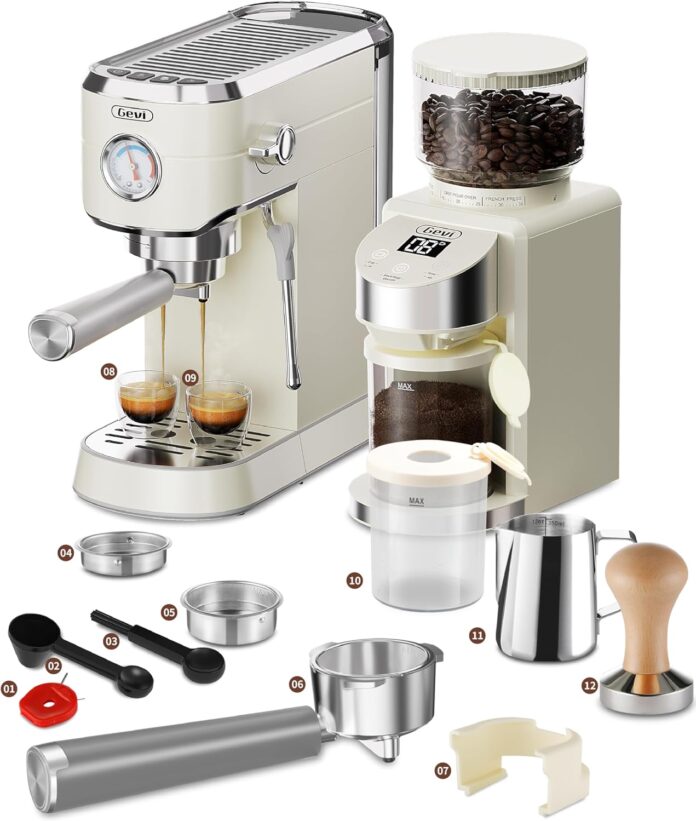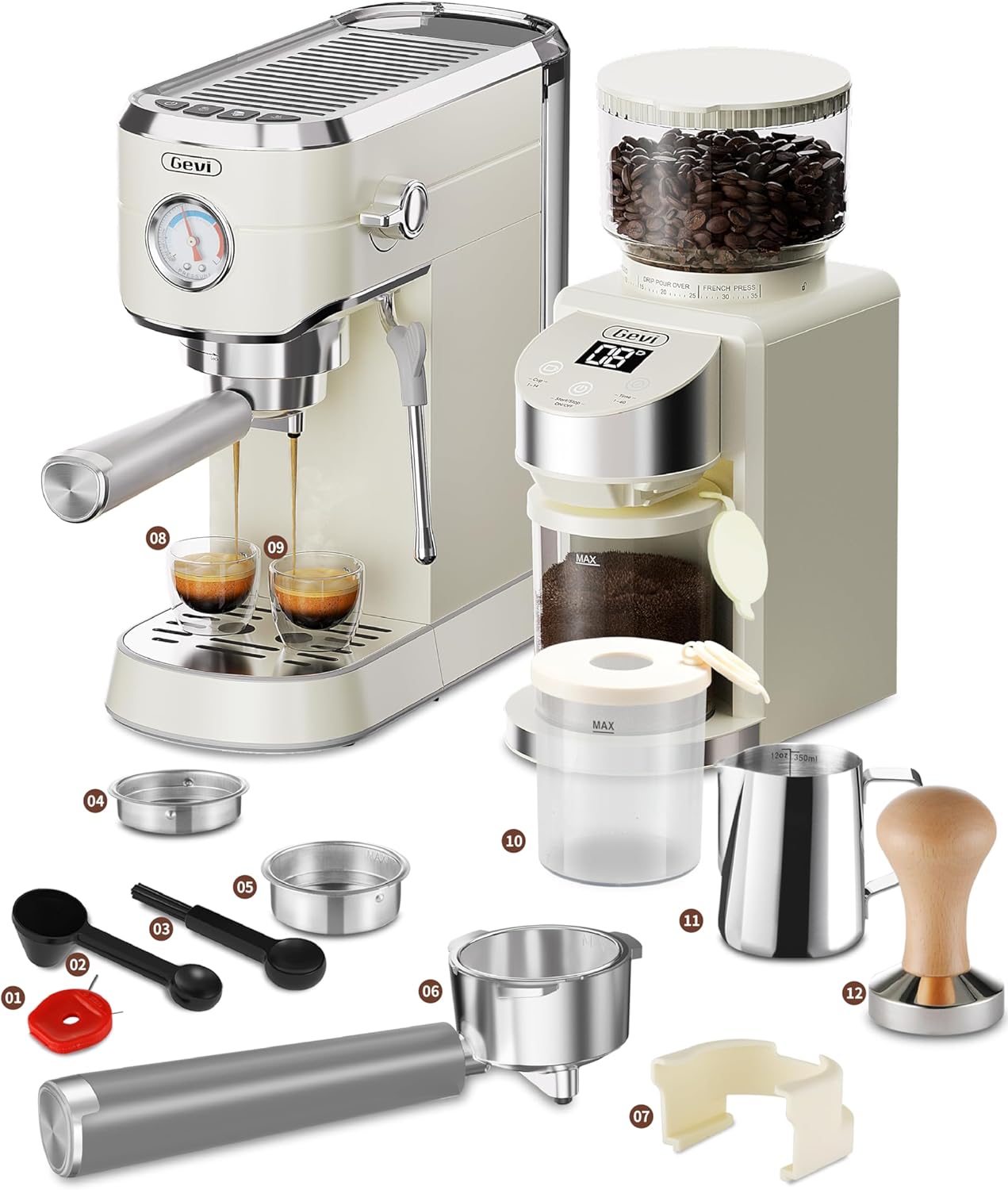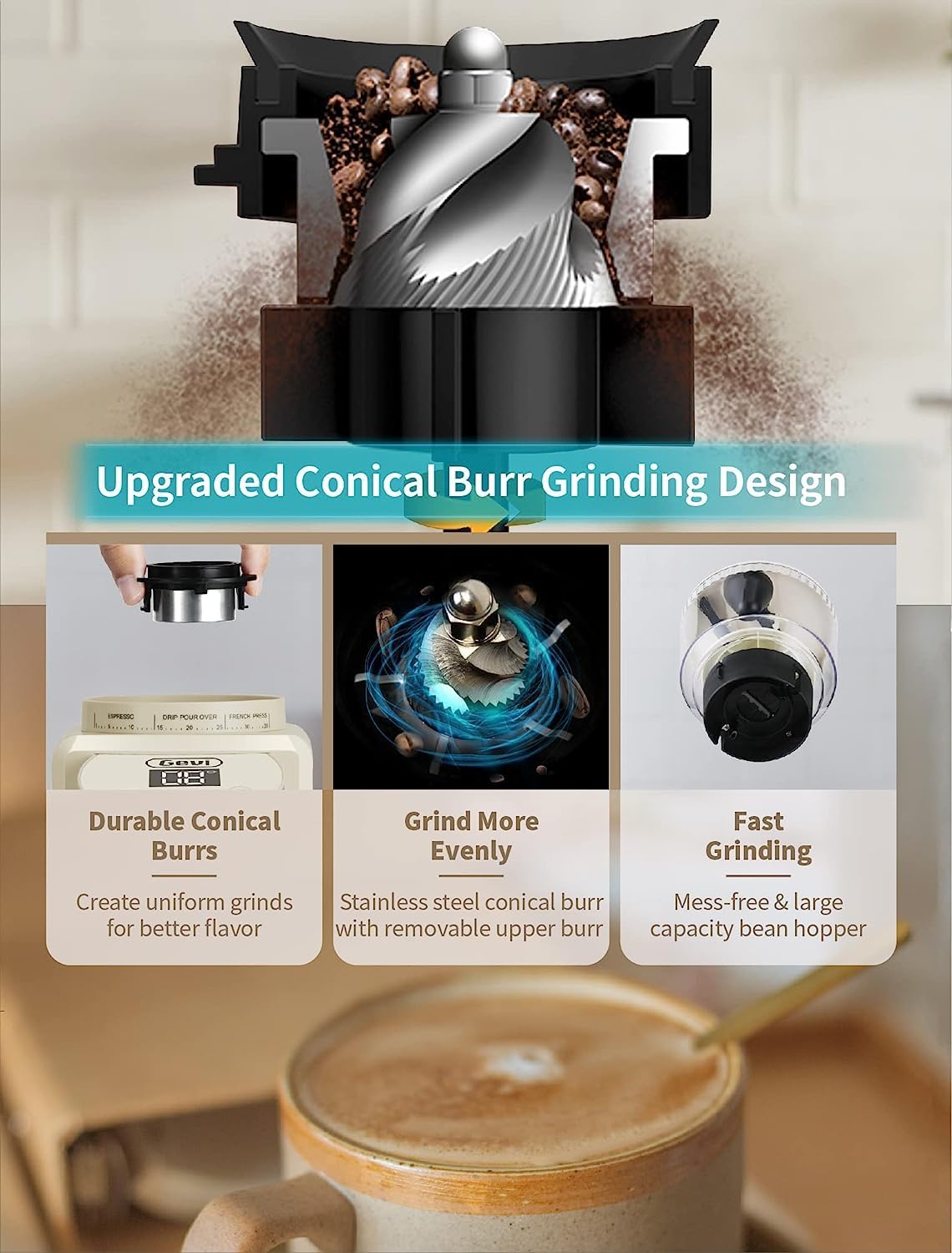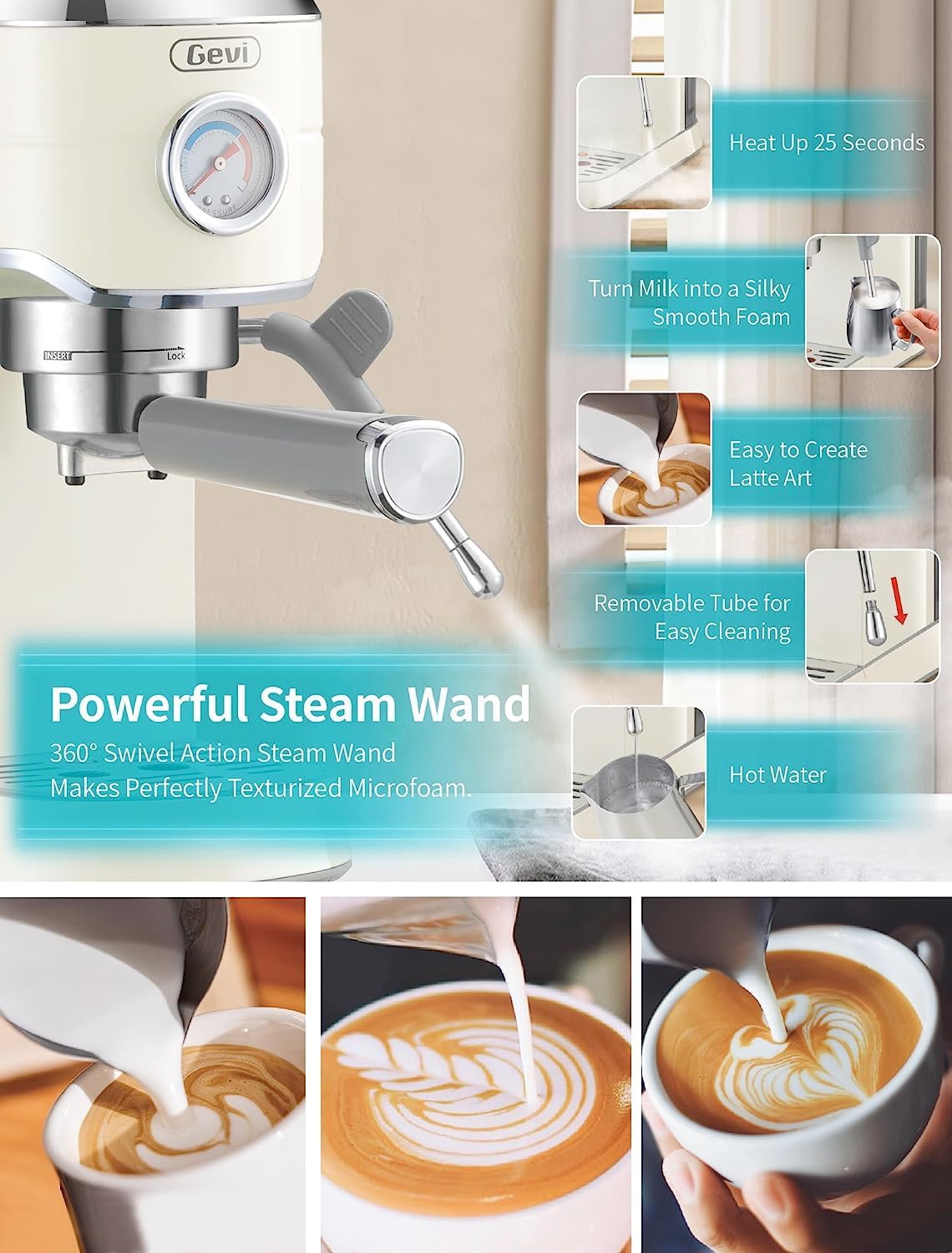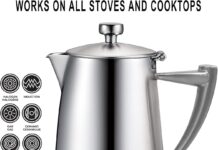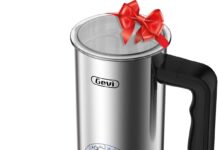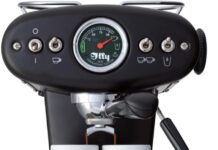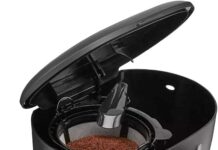Have you ever wanted a compact espresso machine that grinds beans for you and still fits neatly on a small countertop?
My overall impression of the Gevi 20 Bar Compact Professional Espresso Coffee Machine with Milk Frother for Espresso, Latte and Cappuccino Burr Coffee Grinder with 35 Precise Grind Settings, Beige
I’ll be honest: when I first saw the long product name I wondered if the machine could live up to it. After using it for several weeks, I feel like it delivers a lot of features for the price and space it occupies. I appreciate that it integrates a burr grinder, a 20-bar pump, and a milk frother into a relatively compact package that looks pleasant in beige.
Gevi 20 Bar Compact Professional Espresso Coffee Machine with Milk Frother for Espresso, Latte and Cappuccino Burr Coffee Grinder with 35 Precise Grind Settings, Beige
Key specifications and features
I like to have the important numbers and features in front of me, so I can compare quickly. Below is a concise breakdown of the main specs and what they mean in real use.
| Specification | Details | My note |
|---|---|---|
| Pressure | 20 bar pump | Produces good crema and extraction when properly dosed |
| Grinder type | Integrated conical burr grinder | More consistent grind than blade grinders |
| Grind settings | 35 precise settings | Wide range for espresso to coarser brews |
| Filter type | Reusable | Saves waste and reduces cost over paper filters |
| Milk frother | Steam wand / frother | Allows cappuccinos and lattes with some skill |
| Color/Finish | Beige | Neutral, blends into many kitchens |
| Special feature | Integrated coffee grinder | Reduces need for separate grinder |
| Water reservoir | Removable (size varies by model) | Easy to refill and clean |
| Portafilter | Single/double basket | Flexible for small or larger doses |
| Dimensions | Compact footprint | Good for small countertops |
| Target use | Home, small apartments | Not a commercial machine, but very capable |
I find the table helpful, and I returned to it often while testing grind settings versus extraction.
First impressions out of the box
When I unpacked the Gevi machine, I immediately noticed the compact footprint and the beige finish, which looked softer and less clinical than stainless steel. The build feels mostly plastic, but the parts I handle frequently — portafilter, steam wand, and grinder knob — are sturdy enough for daily use. The packaging included basic accessories and a reusable filter, which I appreciated since that’s what I planned to use.
Unboxing and setup experience
Setting it up took me about 20–30 minutes the first time, including reading the manual and cleaning the components they recommend cleaning before first use. I filled the water reservoir, added fresh beans to the hopper, and set my preferred grind level. I walked through a couple of test shots to dial in dose and grind, which felt straightforward even if you’re not a barista.
Design and build quality
I like the compact elegance of the Gevi model. It’s primarily plastic but doesn’t feel flimsy. The beige color gives it a warm, retro-modern look that I think works well in a variety of kitchen decors. Controls are simple: a power button, brew button, and steam control. The hopper and hopper lid feel secure, and the built-in grinder is well integrated so the whole unit feels cohesive rather than an afterthought.
The integrated burr grinder — performance and usability
I was most curious about the integrated conical burr grinder and whether it could consistently produce espresso-worthy grounds. The 35 grind settings give me a granular degree of control. Finer settings are ideal for espresso; coarser settings work if I want a longer extraction or a weaker cup. The grinder’s grind distribution is decent for a built-in unit: it’s not as perfectly uniform as a high-end standalone grinder, but it’s a clear step up from blade grinders and many inexpensive integrated grinders.
- Adjustment: Changing settings is straightforward; I turn the dial to the desired number and pull a test shot.
- Retention: There is some retained coffee in the chute, so I wipe it occasionally to avoid stale oil buildup.
- Hopper capacity: The hopper holds enough beans for several shots before needing a refill, which is convenient for my morning routine.
Pulling shots and extraction quality
With a 20-bar pump, the machine produces strong pressure for crema. I found that grind setting, dose, and tamp consistency mattered more than the machine’s pressure alone. When I used freshly roasted beans, ground appropriately, and tamped evenly, the shots had good crema and balanced flavor. Over-extraction showed bitter notes, while under-extraction tasted sour — which is what you’d expect with any espresso machine.
- Shot timing: I aimed for 25–30 seconds for a double shot and adjusted grind to hit that range.
- Taste: Properly dialed-in shots had rich chocolate and caramel notes; less dialed shots were thin or harsh.
- Consistency: Consistency improved the more I tweaked and recorded settings for my favorite beans.
Milk frother performance
The steam wand makes a big difference for making lattes and cappuccinos. It’s not a commercial-style rotary steam wand, but it produces microfoam when I used the right technique. I had to practice stretching and positioning the tip to get velvety milk rather than large, bubbly foam.
- Latte art: I can produce basic latte art hearts and rosettas with patience.
- Speed: It takes a little longer than high-end machines to steam a full pitcher, but it’s perfectly fine for home use.
- Learning curve: If you’re new to steaming, expect a few practice pitchers to get the technique right.
Temperature and pressure control
Temperature stability is good for a compact home machine. The 20-bar pump provides ample pressure during extraction, though the actual brewing pressure that matters is typically lower after built-in regulation. I noticed consistent temperatures shot to shot after the machine warmed up. It helps to let the machine heat for a few minutes between uses and to purge the group head briefly before extracting.
Grind settings: how I used the 35 precise options
Having 35 settings gives me a lot of control. I created a small log of beans, grind setting, dose, and extraction time so I could reproduce my favorite shots. For example:
- Settings 1–5: Very fine — best for a dark roasted, fine espresso.
- Settings 6–15: Fine-medium — balanced espresso for medium roasts.
- Settings 16–25: Medium — for longer extractions or filter-like extractions.
- Settings 26–35: Coarse — suitable if I’m experimenting or making a weak americano.
I found that small adjustments (one or two notches) often made noticeable changes in shot timing and taste.
Noise level during grinding and brewing
The grinder and pump are audible but not painfully loud. The grinder emits a moderate whirring that I found acceptable in the morning. The pump makes the usual pulsating sound during extraction. Overall, noise levels are comparable to other integrated grinder espresso machines in this price and size range.
Water reservoir and filter type
The Gevi uses a removable water reservoir that’s easy to refill. The reusable filter included helps reduce waste and saves money over time, though I still keep paper filters on hand for very fine grounds if I want cleaner extraction. The reservoir seals well, and I had no issues with leaks.
Portafilter, baskets, and dosing
The portafilter is comfortable to use and comes with single and double baskets (varies by package). I used the double basket most often for richer shots. Dosing is manual, so I recommend a small scale if you want precise dose control — that improved my consistency significantly.
Cleaning and maintenance
Cleaning is straightforward but important. I clean the portafilter, baskets, and steam wand after each use to prevent milk residue. The reusable filter should be rinsed after each brew. Descaling should be done periodically depending on water hardness and use frequency. The machine’s removable parts are accessible, which makes regular maintenance easier.
- Daily: Rinse portafilter, purge steam wand, empty drip tray.
- Weekly: Backflush if supported, clean hopper and grinder chute.
- Monthly: Descale as needed and deep clean steam wand.
Durability and long-term concerns
During my weeks of testing, I didn’t encounter mechanical failures. However, integrated grinders and compact pumps can show wear faster than higher-end separates if used heavily. For typical home use I expect reasonable longevity, but heavy daily use might stress internal components sooner than a commercial-segment machine.
A closer look at the reusable filter
I appreciate the reusable filter because it’s eco-friendlier and cuts ongoing costs. It’s easy to rinse and doesn’t create the paper waste of pod or paper filters. That said, it requires careful cleaning to avoid taste contamination between brews.
Practical tips I learned while using the Gevi
I kept a few practical tips that made my life easier with this machine:
- Preheat portafilter: Lock in the portafilter and run a short blank shot to stabilize temperature.
- Fresh beans: Use freshly roasted beans and adjust grind daily; even a single day’s aging can change extraction.
- Scale your dose: A small scale made my shots much more repeatable than eye-balling tamp or dose.
- Clean the wand immediately: Milk dries fast; wiping it right away prevents clogs.
- Keep a log: Note grind setting, dose, and shot time for each bean to quickly replicate the best results.
Recipes and drink ideas I made
I experimented with a range of drinks and found the machine versatile:
- Straight espresso: 18–20g double dose, 25–30s extraction.
- Americano: Shot + hot water for a longer, softer cup.
- Latte: 1:2 espresso to steamed milk ratio, microfoam for texture.
- Cappuccino: More foam and a shorter milk volume for a balanced cup.
- Flat white: Slightly lower milk volume and smoother microfoam. I liked how the grinder allowed me to tailor the extraction for different bean roast profiles.
Troubleshooting common issues and my fixes
When things didn’t work perfectly, here are common issues I ran into and how I addressed them:
- Bitter espresso: Grind finer or reduce dose/taming of extraction time.
- Sour espresso: Grind finer or increase dose; also check freshness of beans.
- Weak crema: Ensure proper grind/fresh beans and preheat machine.
- Steam wand sputter: Purge before steaming and make sure the wand nozzle is clean.
- Grinder clogging: Occasionally clear retained grounds and reduce oil buildup by cleaning chute.
Who should consider this machine
I recommend this Gevi machine if:
- You want an all-in-one compact espresso solution with an integrated grinder.
- You have limited counter space but want quality espresso, latte, and cappuccino options.
- You’re willing to learn basic tamping and steaming techniques to get the most out of it. I would not recommend it to someone who expects commercial reliability under heavy daily use or who requires the absolute finest grind uniformity a high-end standalone burr grinder delivers.
Who might want something else
If you need near-silent grinding, the absolute top-of-the-line grind uniformity, or heavy-duty commercial use, you may prefer spending more on a separate premium grinder and a commercial-grade espresso machine. This Gevi is a fantastic home appliance but not a replacement for professional equipment.
Comparisons with a few alternatives
I compared the Gevi with similar built-in grinder espresso machines in the same segment, and here’s how it stacks up in my experience:
- Versus cheaper machines with blade grinders: The Gevi’s burr grinder wins for flavor consistency and finer grind control.
- Versus more expensive integrated machines: Higher-end models may offer better temperature stability, metal construction, and quieter grinders, but they cost significantly more.
- Versus separate grinder + machine pairs: A separate higher-end grinder and machine will outperform in consistency and durability, but they need more space and budget.
Value for money
I felt the Gevi gives strong value for money. You get a 20-bar pump, a built-in burr grinder with 35 settings, and a milk frother in one compact unit, which is hard to match at this price point. For a home user wanting to upgrade from pods or low-end machines, this one strikes a good balance between price, features, and performance.
Accessories and extras I found useful
I purchased a few inexpensive extras that improved my experience:
- A 60–100g coffee scale for dosing.
- A small tamp mat to protect counters.
- A cleaning brush for the grinder chute.
- Milk pitcher with measurement marks for consistent milk volumes. These items aren’t required but made brewing more consistent and enjoyable.
A short maintenance checklist I followed
Consistency comes from routine. I followed this checklist to keep the machine happy:
- Daily: Wipe steam wand, empty drip tray, rinse portafilter.
- Weekly: Clean grinder chute and hopper, run a cleaning cycle if recommended.
- Monthly: Descale based on water hardness and frequency of use. This regimen kept flavor clean and reduced the chance of mechanical issues.
The aesthetics — beige color and kitchen fit
I’m fond of the beige finish; it’s subtle and less industrial than black or stainless steel. It blends nicely with wood tones and neutral counters. If you want a modern retro look, this color works. The compact shape helps it tuck under cabinets or occupy a corner without overwhelming the counter.
Safety notes and best practices
I always recommend following basic safety practices:
- Don’t leave the machine on unattended for long periods.
- Allow the steam wand to cool before touching after use.
- Use filtered water if your tap water is hard to reduce descaling frequency. I follow those rules to protect the machine and myself.
Environmental and cost considerations
Using the reusable filter reduces paper waste and saves money. Also, using freshly ground beans means I can buy whole beans in bulk, which is often cheaper and fresher than pre-ground or pod-based systems. Descaling and maintaining the machine prolong its life and reduces the need to replace it prematurely.
Common questions I answered for myself
In testing, I asked myself several practical questions:
- Can it make a good cappuccino? Yes, with practice on milk steaming.
- Is the grinder adjustable enough? Yes, the 35 settings offer detailed control.
- Is it easy to clean? Yes, most routine tasks are straightforward.
- Is it quiet? Moderately quiet; not silent. Answering these helped me decide whether it fit my daily routine.
Pros I found
I liked many things about this machine:
- Solid value with integrated grinder and frother.
- 35 grind settings for control and flexibility.
- Compact footprint suitable for small kitchens.
- Reusable filter included for eco-friendly brewing.
- Pleasant beige aesthetic that blends into many kitchens.
Cons I encountered
No product is perfect, so here are the downsides I experienced:
- Plastic-heavy construction may not satisfy those who want metal-bodied machines.
- Grinder isn’t as consistent as standalone premium grinders.
- Some retained grounds in the chute require occasional cleaning.
- Steam wand takes practice to master for silky microfoam. I found these manageable for home use but important to weigh before buying.
Practical daily routine I established
I settled into a simple morning routine:
- Fill water reservoir the night before.
- Refill hopper with fresh beans.
- Preheat machine and portafilter.
- Grind and dose on my preferred setting.
- Extract, steam milk, and enjoy. This routine got me consistent cups with minimal fuss once I recorded my preferred grind/dose.
Long-term reliability expectations
From the build and my weeks of use, I expect reasonable reliability for casual home use. The grinder and pump are the most used components and could show wear over years, especially with heavy daily use. Regular maintenance can significantly extend the machine’s life.
Warranty and support considerations
I recommend checking the exact warranty terms with the retailer at purchase. Having a clear warranty and access to spare parts or customer support can make a big difference if something fails. I found manufacturer support generally helpful when I had minor setup questions.
Final verdict and recommendation
After spending time with the Gevi 20 Bar Compact Professional Espresso Coffee Machine with Milk Frother for Espresso, Latte and Cappuccino Burr Coffee Grinder with 35 Precise Grind Settings, Beige, I feel it strikes a strong balance between cost, convenience, and coffee quality for home users. If you want an all-in-one machine that grinds, brews, and steams without taking up much space, and you’re willing to practice tamping and steaming, this model is an excellent choice. If you demand commercial-grade durability or the absolute best grinder performance, consider higher-end separate components, but for most home enthusiasts, the Gevi offers a lot of capability for the price.
If you want, I can help you pick ideal grind settings for a particular bean or walk you through a short checklist to dial in your first espresso shot with this machine.
Disclosure: As an Amazon Associate, I earn from qualifying purchases.


